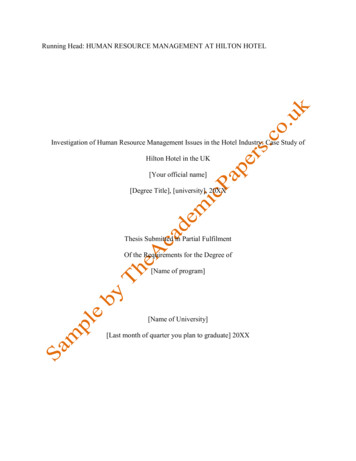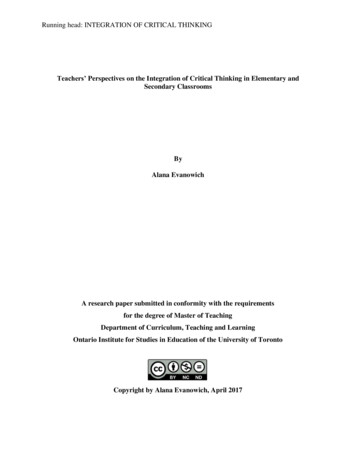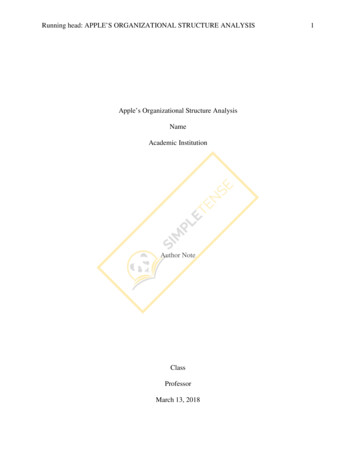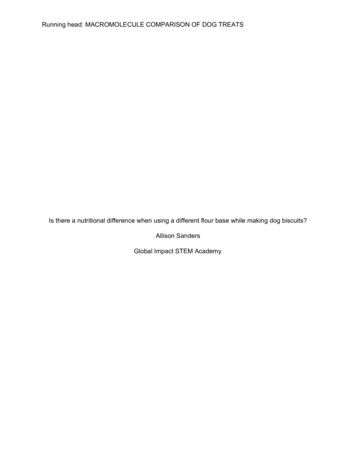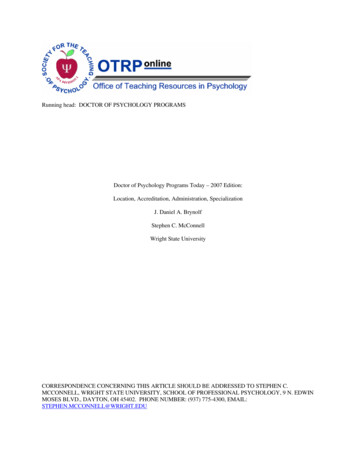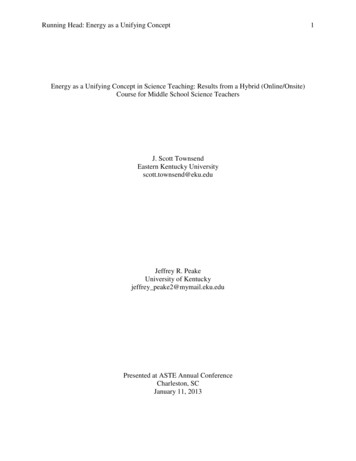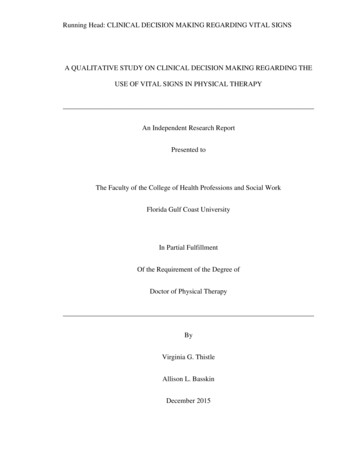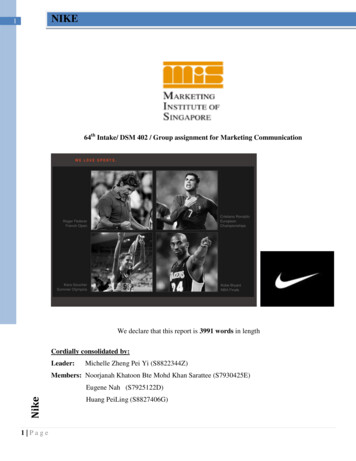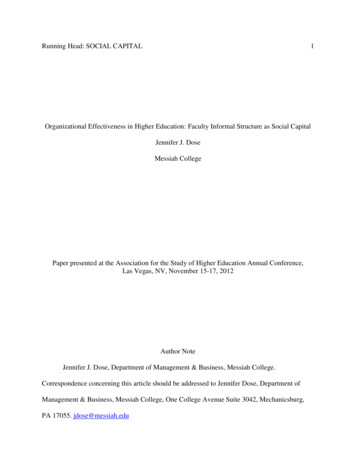
Transcription
Running Head: SOCIAL CAPITAL1Organizational Effectiveness in Higher Education: Faculty Informal Structure as Social CapitalJennifer J. DoseMessiah CollegePaper presented at the Association for the Study of Higher Education Annual Conference,Las Vegas, NV, November 15-17, 2012Author NoteJennifer J. Dose, Department of Management & Business, Messiah College.Correspondence concerning this article should be addressed to Jennifer Dose, Department ofManagement & Business, Messiah College, One College Avenue Suite 3042, Mechanicsburg,PA 17055. jdose@messiah.edu
SOCIAL CAPITAL2AbstractHigher education institutions encounter complex external environments, requiring increasingresponsiveness and innovation. Research on social capital has demonstrated that highlyconnected employee relational networks are more creative, effective, and exhibit higher membersatisfaction. The present study examines one college to demonstrate how social network analysiscan be used to assess the informal relational networks of faculty members within a highereducation institution. Characteristics of the faculty social network are described and mapped.The relationship between aspects of individuals’ network linkages, governance participation, andtheir organizational commitment, satisfaction, and trust are assessed. Recommendations forbuilding effective organizational networks, particularly through expanding participation incollege governance, are provided.
SOCIAL CAPITAL3Organizational Effectiveness in Higher Education: Faculty Informal Structure as Social CapitalHigher education is no stranger to the need to be increasingly innovative and responsiveto a complex and changing environment. Pressures include greater competition, constrainedresources, competing priorities, complexity of student profiles and increased demands, shifts to alearning-centered orientation, and new information technology. These pressures combine withexternal demands for quality, cost effectiveness, community engagement, solutions to socialproblems, and building the economy through innovative research—all existing within a shorterdecision time frame (Berberet, 2002; Kezar & Eckel, 2004; Longin, 2002). At the same time,higher education struggles with the accountability and governance structures necessary to meetthese challenges in a timely fashion. Although such a multivariate complex situation necessitatesa multipronged solution, building social capital through relational networks is a strategy that canplay an important role in meeting the challenges of the environment that higher education faces.Research conducted in all types of organizations provides strong support for the idea thatthe network of relationships among organizational members is a vital resource for responsivenessto a changing environment, innovation, member satisfaction, and commitment (Cross, Baker, &Parker, 2003; Cross, Borgatti, & Parker, 2002; Kezar & Lester, 2009a). Of course, theknowledge, skills, and abilities of organizational members themselves is a key precursor to thevalue of relationships between these members. Nahapiet and Ghoshal (1998) define social capitalas “the sum of the actual and potential resources embedded within, available through, andderived from the network of relationships possessed by an individual or social unit” (p. 243). Thebetter an organization is at developing these relational conduits for knowledge and ideas, thebetter it is at building creative responses to the challenges it faces, whether it be developing newproducts or services, entering new markets, increasing customer satisfaction, or finding ways to
SOCIAL CAPITAL4fill important goals and objectives more efficiently and effectively (Cross, Liedtka, & Weiss,2005). It is important to note that this network of relationships is distinct from the formalorganizational structure—the hierarchy depicted on organizational charts. Rather, the informalstructure in which organizational members from different disciplines or functional areascollaborate and share ideas is key to describing the network of relationships that build socialcapital.This paper describes how social network analysis can be used to assess the social capitalpotential of higher education institutions and demonstrates its potential to impact facultymembers’ attitudes toward the organization (e.g., commitment, satisfaction). To date, there hasbeen no application of quantitative social network analysis techniques in a higher educationcontext. Social network analysis is a technique developed from sociology (originating with thesociogram) and mathematics in which characteristics of the relationships between a set ofindividuals rather than characteristics of the individuals themselves are the main point of interest(Marin & Wellman, 2011). Specialized computer programs can be used to plot the relationalnetworks and determine how sparse or dense the network is, which members have the mostconnections to others, and where the network is disconnected. Some networks may exhibitsubgroups or factions while others have relationships that are evenly distributed and allowinformation to travel with ease throughout the network. Organizational networks can alsodescribe different types of relationships, for example, simply whether or not members know oneanother, whom they would ask for help, whom they communicate with frequently, etc. Previouswork in social network analysis has demonstrated significant relationships between networkattributes and outcome such as information diffusion (Schaefer, 2011), creativity (Perry-Smith,
SOCIAL CAPITAL52006), team effectiveness (Balkundi & Harrison, 2006; Cummings & Cross, 2003), and jobsatisfaction (Flap & Vӧlker, 2001).The current study uses the case of one higher education institution to examine therelationship between network structure and several organizational attitude variables:organizational commitment, trust, and job satisfaction. In addition, participation in various rolesis assessed, e.g., institutional shared governance, faculty development activities, andinterdepartmental initiatives. This research proposes that membership in such activities buildsrelationships that have positive implications for the attributes of organizational network structurewhich are beneficial for collaboration and innovation, and that individuals with networkcharacteristics such as a large number of relationships and central placement within the structurewill demonstrate greater job satisfaction, organizational commitment and trust. A network thatexhibits these attributes has the potential to build an effective response to the challenges facinghigher educational institutions.The organization of the paper is as follows. First, a conceptual background on socialcapital and relevant previous research on organizational structure and organizationaleffectiveness is provided, noting the importance of member interaction for satisfaction,commitment, innovation, and problem solving. Next, an introduction to the technique of socialnetwork analysis and key research findings are provided. Rationale for the relational networkvariables to be used in the study is discussed. The research methodology and setting focuses on awhole-network survey and network analysis of the all faculty at a particular institution, andaddress relationships between network characteristics, member attitudes, and participation ingovernance. Finally, the study makes recommendations for improving the network structure.
SOCIAL CAPITAL6Social CapitalFerren, Kennan, and Lerch (2001) propose that in higher education as well as other typesof organizations, the value of social capital is equal to other assets such as financial capital orhuman capital (expertise). Social capital can be considered as both a collective and an individualgood (Lin, 2001); the embedded resources are expected to benefit both individuals’ opportunitiesand organizational viability (Coleman, 1988; Putnam, 2000). Social capital is built through thenetwork of relationships and corresponding resources to which an individual has access, or, at anorganizational level, the aggregate of these relationships between organizational members (Lin,2001). Resources embedded in social networks facilitate flow of information, exert influence,provide social credentials, and reinforce identity. Unlike other forms of capital, social capital isless tangible, existing within the structure of relations between actors (Coleman, 1988), ratherthan the actors themselves. Coleman has noted that “acquisition of information is costly, at aminimum requiring attention, which is always in scarce supply” (p. S104).At the organizational level, social capital has three basic components: “the network; acluster of norm, values, and expectancies that are shared by group members; and sanctions—punishments and rewards—that help maintain the norms and the network” (Halpern, 2005, p. 10)and improve group efficacy by facilitating coordinated action (Putnam, 2000). Coleman (1988)provided an excellent example of how these components work together when he described thewholesale diamond market in which merchants hand over bags of diamonds, worth manythousands of dollars, to other merchants to examine at their leisure. The arrangement workseffectively only because of the high degree of trust and trustworthiness among the community ofmerchants; their close business relationship and common understanding of appropriate behavior
SOCIAL CAPITAL7allows for the free flow of information without requiring expensive or complicated contracts orinsurance. Social capital requires developing a sense of trust (Lesser & Storck, 2003).Aspects of the social capital network can be characterized in various ways. An importantdistinction exists between bonding and bridging capital. Bonding capital reinforces groupidentity while bridging capital is more outward focused, seeking linkages across groups(Halpern, 2005, p. 19, see also Putnam, 2000). In both types of social capital, goodwill towardone another is key, as is allowing for some sort of behavior to take place (as in the diamondmerchants). The contrast between bonding and bridging capital also parallels Granovetter’s(1973) distinction between strong and weak ties, strong ties being centered around one’s closesupport network of family and friends, while weak ties consist of acquaintances and othercontacts which become useful for seeking information and other opportunities. Access and use ofsocial resources is determined by position/location in network, (e.g., structural holes; Burt 1992).Gladwell (2000) gave the example of religious leader John Wesley as a “connector,” notonly having ties to many people, but people in many different groups. New or changed ideasneed a community around them where they can be nurtured and practiced. As with other formsof capital, social capital describes the resources that one’s social network enables an individualto access. At the individual level, elements of social capital are: (1) number of persons withinone’s social network prepared to help when called upon to do so; (2) strength of relationship; (3)resources of the persons (Flap & Vӧlker, 2001). Although size and density of the social capitalnetwork is important, ultimately the value of these relationships for social support or informationdetermines the actual “capital.”
SOCIAL CAPITAL8Organizational StructureThe linkages between organizational members are more complex than they may appear atfirst glance. Formal structure arises from the configuration of roles while informal structurearises from the process of interaction (Ransom, Hinings, & Greenwood, 1980). Like mostorganizations, higher education institutions have a formal organizational structure. Employees,including faculty, are placed into departmental units and have a place in a hierarchy depicted byan organizational chart. In addition to the formal structure, employees may initiate, or theorganization may foster, less formal structures such as communities of practice (Cross, Nohria,& Parker, 2002; Lesser & Storck, 2003), such as reading groups, new employee seminars,informational talks. Employees may have contacts with areas of expertise or friendships withinthe organization that exist due to common interests inside or outside the organization.Also like many other organizations, higher education institutions implement what isknown as a parallel or collateral structure (Bushe & Shani, 1998) designed to foster participationin organizational decision making by employees throughout the hierarchy who are likely to haverelevant insights. Like quality circles or other parallel structures in business organizations, sharedgovernance models bring together employees whose work is central to the mission of theorganization with other employees in supporting or management roles. Due to the cross-unitrepresentational nature of committee elections and appointments by peers, governancerelationships have significant potential implications for the social capital and networkrelationships within an institution. Committee members will expand the informal organizationalnetwork by connecting with others whom they may not otherwise interact, and such interactionscontain the potential for new ideas.
SOCIAL CAPITAL9Organizational EffectivenessEffectiveness criteria for higher education organizations include Cameron’s (1978)widely-cited list: student educational satisfaction, student academic development, student careerdevelopment, student personal development, faculty and administrative employment satisfaction,professional development and quality of the faculty, systems openness and communityinteraction, ability to acquire resources, and organizational health. Several of these criteria areparticularly relevant for social capital and informal network structure, including organizationalattitudes variables such as job satisfaction, organizational commitment, and trust (Cameron,1978; Lesser & Storck, 2003). Relations
of capital, social capital describes the resources that one’s social network enables an individual to access. At the individual level, elements of social capital are: (1) number of persons within one’s social network prepared to help when called upon to do so; (2) strength of relationship; (3) resources of the persons (Flap & Vӧlker, 2001). Although size and density of the social capital
